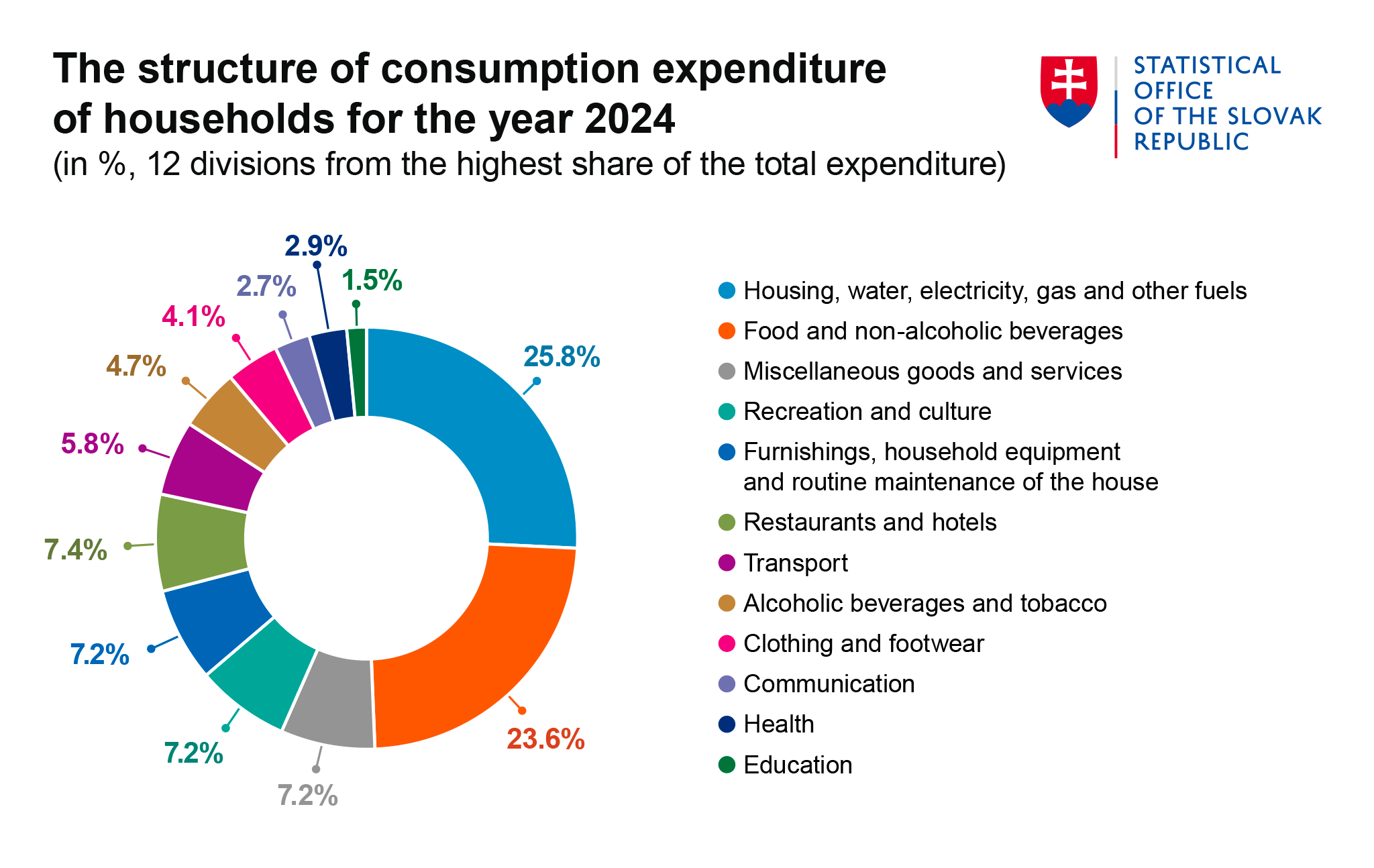Inflation continues decreasing, in April prices rose only by 2.1%
The prices of alcohol and tobacco, fuel, personal care products and services increased month-on-month. Higher administrative fees increased by a quarter as part of the consolidation of public finances also had a significant impact on price growth. Even in the year-on-year comparison, inflation, i.e. price growth, was influenced by less significant components in terms of household expenses. Food prices have stagnated year-on-year and have even become cheaper month-on-month for the second consecutive month.
Consumer prices of goods and services increased by 0.3% month-on-month in April. Year-on-year inflation continued to decline for the 15th consecutive month and prices were currently higher by 2.1% than a year ago. It was the lowest level of inflation in the last three years.
Download high resolution chart format PDF (85 kB) or PNG (108 kB).
Month-on-month development - April 2024 compared to March 2024
In April, consumer prices rose only very slightly month-on-month. Out of a total of 12 divisions (household expenditure groups), price growth was evident in 10, and prices dropped in 2. The greatest impact on was the increase in fuel prices (2.0%) and air tickets in transportation. The second most fundamental impact was the price rise in the miscellaneous goods and services division, which was due to more expensive goods, aids and services for personal care, but also an almost quarter increase in administrative fees after the amendment of the legislation (other services). The third most significant impact in terms of price growth was the continued increase in prices of alcoholic beverages and tobacco, especially beer by 2.9% and tobacco by 0.7%.
On the contrary, the continued price decrease of food and non-alcoholic beverages1) had a significantly dampening effect on price growth, their prices dropped by 0.3% compared to March, due to price decreases in 6 out of 9 monitored food structures. Consumers paid less mainly for fruit, milk, cheese and eggs, as well as vegetables, bread and cereals. A more significant decrease in food was prevented by month-on-month increases in the prices of sugar and confectionery, as well as oils and fats, and finally also non-alcoholic beverages.
The drop in prices in April was also reflected in the field of furniture and furnishings.
Year-on-year price development in April 2024 compared to April 2023
In April, inflation in a year-on-year comparison reached a growth level of 2.1%. Prices were higher than a year ago in 11 divisions (household expenditure groups), and in one division - recreation and culture – where the prices remained unchanged. The most significant impact on the value of inflation was year-on-year higher prices in three divisions of the consumer basket: transportation, alcohol and tobacco, and also in other goods and services.
In the field of alcohol and tobacco products, the overall rate of inflation has been negatively affected for several months by more expensive distillates (currently by 16.2% in April) and tobacco (by 9.7%), mainly responding to the increase in excise taxes. A significant impact was the price increase in transportation by almost 7%, mainly due to year-on-year more expensive fuels, but also transportation services, especially in the field of bus transport. The third major impact at the year-on-year level was the price growth by 4.7% than a year ago for personal care items and services (hairdressing services, drugstore for personal hygiene, etc.).
Important information for consumers was that the two most significant expenditure groups of the Slovak households - food with non-alcoholic beverages and housing with energy – affected the price growth only minimally. After almost three years, food was as expensive as a year ago. However, it was still only on average, because the 3 components with lower prices compensated for the slight price increases of 6 other food components. Milk, cheese, eggs, vegetables as well as oils and fats were sold 1-6% cheaper year-on-year. Conversely, consumers paid slightly up to 4% more than a year ago for bread with cereals, meat, fruit, but also sugar and confectionery.
In total, in the first four months of 2024, inflation (higher consumer prices) reached 2.9%.
Development of core and net inflation
In April the total year-on-year inflation rate was 2.1%, core inflation reached 2.3% and net inflation reached 3.1%. Month-on-month core inflation reached a value of 0.3% and net inflation reached 0.5%.
Core inflation was affected by price level growth after excluding the impact of changes in regulated prices (e.g. energy prices) and other administrative measures (e.g. tax adjustments, etc.). Net inflation is core inflation without changes in food prices.
Inflation of selected social groups
Currently, together with price growth for all types of households, the Office exceptionally earlier also publishes aggregated data on the increase or decrease of consumer prices valid for different social groups (in households of employees, pensioners and low-income households). The reason is a regular approval of legislation for adjustments to the living wage. The Office will publish detailed data on the topic of inflation in households of different social groups according to the First Release Calendar on 27 May 2024.
Currently, in April, prices in households of employees and in low-income households increased month-on-month by 0.3%, and they increased in households of pensioners by 0.2%. Inflation (year-on-year price growth) in households of employees reached 2.2%, in low-income households 1.9% and in households of pensioners by 1.4%.
In total, for the four months of 2024, consumer prices increased year-on-year in households of employees by 3%, in low-income households by 2.8%, and in households of pensioners by 2.3%.











 Help
Help